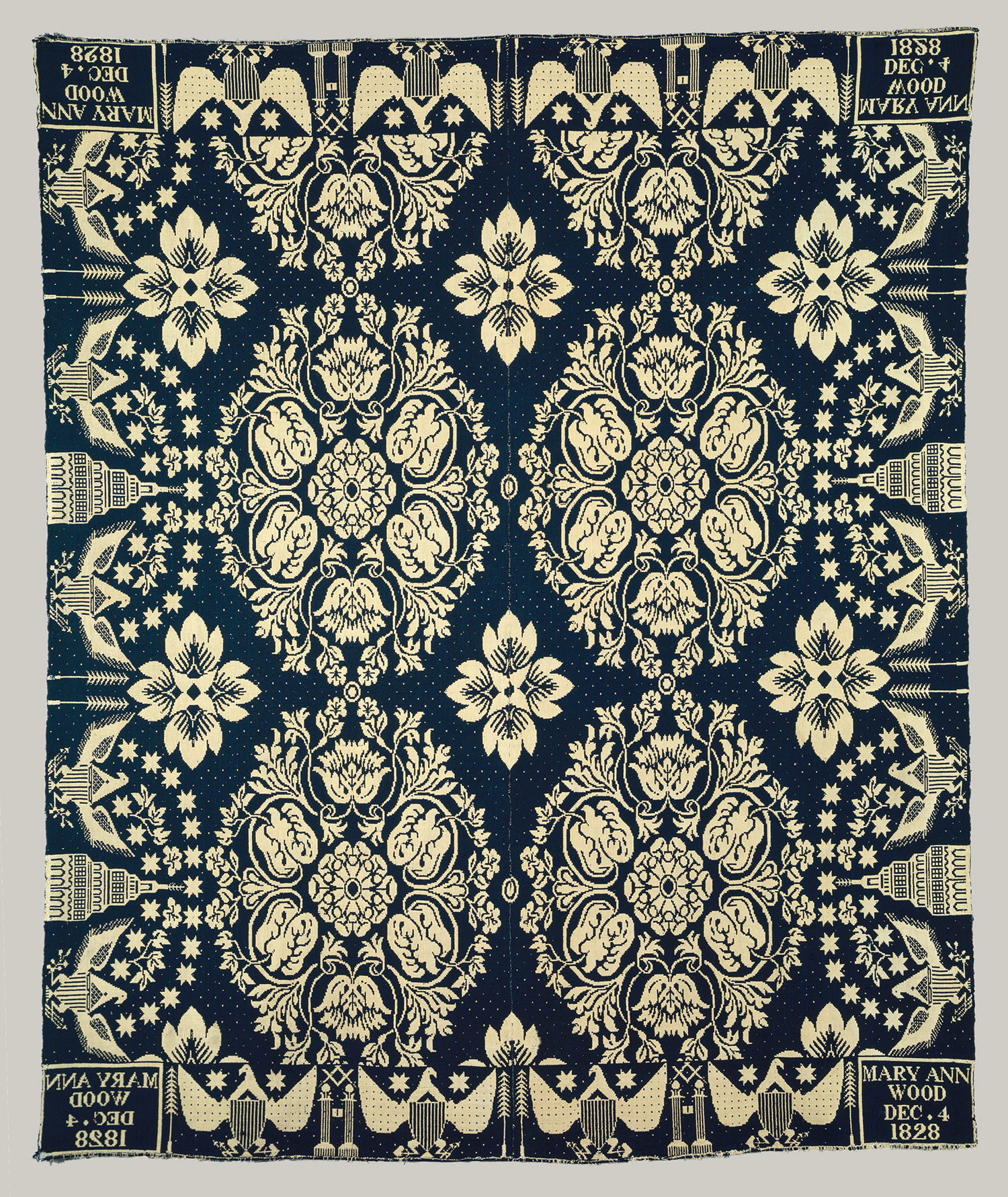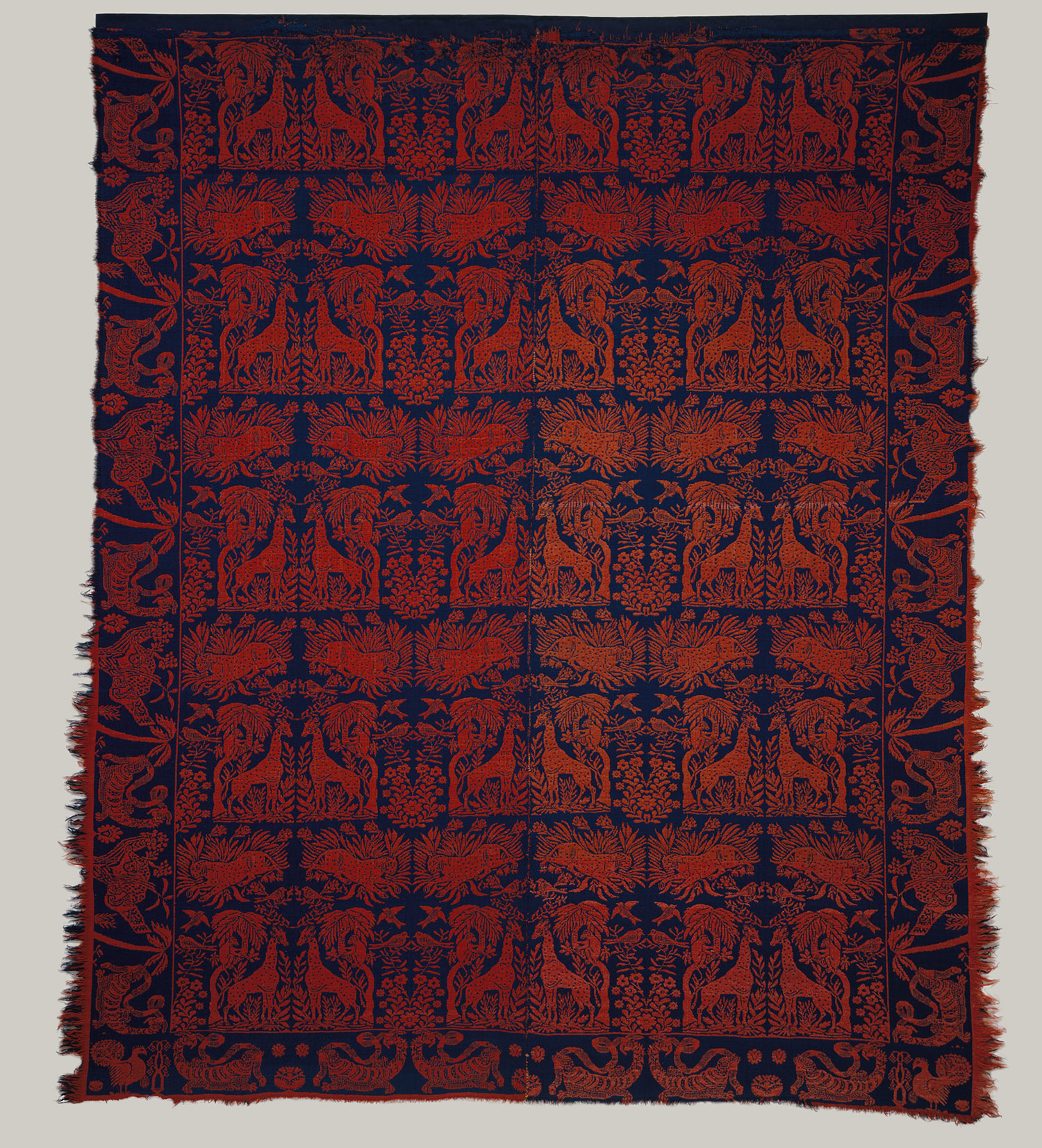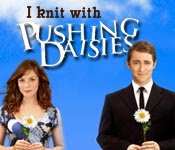 Picture from the National Museum of the American Coverlet website
Picture from the National Museum of the American Coverlet website(sidenote: that is the style of walking wheel that I have)
Early Coverlets
American coverlets, according to the gentleman who took me on an in-depth personal tour of the museum, are a thoroughly American art. They are woven blankets which were made in America (and limited parts of Canada) by European weavers who had emigrated to America. Early coverlets are defined by their geometric designs. Early ones typically have a center seam because the looms that wove them were small. One of the examples in the museum was really interesting because the coverlet had been taken apart, repaired and sewn back incorrectly. The border of one side was sewn together with the center of the other side. The early weavers created geometric patterns because they were limited by their technology. At the time, the looms they owned were unable to make complex designs. All of that changed when the Jacquard loom was brought to America.
Jacquard looms
As those interested in the history of computers will know, a Jacquard loom is an example of an early computer. A Jacquard loom is, according to Merriam-Webster, "a loom designed to weave fabrics of intricate design whose control mechanism makes use of cards with holes punched in them."
Those cards allowed weavers to move beyond the simple geometric designs. Suddenly, they could make works of art rather than just beautiful blankets. At this time, coverlets began being signed and dated thanks to the Jacquard loom.
 Scanned image from American Coverlets and Their Weavers
Scanned image from American Coverlets and Their WeaversAccording to the gentleman at the museum, the woman's name on the coverlet always refers to the recipient of the coverlet. There is only one recorded instance of a woman weaver making woven coverlets. The investment cost for purchase of the Jacquard loom and punchcards was so much that only well-established men could afford to buy them. The lady who wove coverlets inherited the loom and punchcards from her father.
The signature blocks allow us to know such a wealth of information about the weavers and their recipients. If you have a chance, take a look at the book, American Coverlets and Their Weavers by Clarita Anderson. The author looked through numerous census records and was able to find some fascinating information about the weavers.
Coverlets as art and function
I found it very interesting to learn that coverlets were probably one of the first things in a household that were bought simply to be pretty. The first items bought (or made) for a house would be things like furniture or kitchen equipment. A coverlet, on the other hand, was extremely expensive and would only be displayed on the master bed.
Melting Pot of America
In a very physical way, coverlets show explain why America is called a melting pot. When the European weavers first settled in America, their coverlets had distinct images and styles. For instance, a German weaver's coverlet reminded me very much of hex signs found on Pennsylvania Dutch barns.
The signature blocks allow us to know such a wealth of information about the weavers and their recipients. If you have a chance, take a look at the book, American Coverlets and Their Weavers by Clarita Anderson. The author looked through numerous census records and was able to find some fascinating information about the weavers.
Coverlets as art and function
I found it very interesting to learn that coverlets were probably one of the first things in a household that were bought simply to be pretty. The first items bought (or made) for a house would be things like furniture or kitchen equipment. A coverlet, on the other hand, was extremely expensive and would only be displayed on the master bed.
Melting Pot of America
In a very physical way, coverlets show explain why America is called a melting pot. When the European weavers first settled in America, their coverlets had distinct images and styles. For instance, a German weaver's coverlet reminded me very much of hex signs found on Pennsylvania Dutch barns.
 New York quilt, The Metropolitan Museum of Art
New York quilt, The Metropolitan Museum of ArtOnce the weavers began moving west, however, their styles began to blend. Elements of the different nationalities as well as traditional American symbols were common. By the time the weavers hit Indiana, they had developed a very cohesive style. The following image is from a coverlet that the Metropolitan Museum of Art believes was woven by an Ohio weaver. It shows a combination of the different elements.
Country Living had an article in the May 2007 issue about American coverlets. If you would like additional information, click here.
Stay at Home and Use Me Well Exhibit
From now until next year, the museum is having a special exhibit of spinning wheels and accessories.
 I don't have any pictures from this display because I was the only person there and was having a guided tour. I'm sure Mr. Zongor wouldn't have minded but I didn't want to impose.
I don't have any pictures from this display because I was the only person there and was having a guided tour. I'm sure Mr. Zongor wouldn't have minded but I didn't want to impose.The wheels on display were the property of one man. Now, that doesn't sound that impressive until you see how many items were in the museum. I can't even picture where that man keeps it all! It makes me wonder how I can work it so that he adopts me. The variety of wheels were simply amazing. He had walking wheels, production wheels, a pulley wheel, flax wheels, wool wheels, upright wheels, more traditional wheels, double flyer wheels, TONS of mothers of all, etc etc. AMAZING. If you are interested in antique spinning wheels at all, go see the exhibit. It was really fascinating to see all of the different types in one place.
If you are in the area, make sure you drop by the museum. For a small museum, they have really good hours. They are located in historical Bedford, PA right off of the PA turnpike.












2 comments:
Great summary of your visit. I will definitely have to make it out there while this exhibit is on display! And if I see Mr. Zonger, I'll tell him you sent me. :)
The coverlets were so beautiful, sounds like a great way to spend the day.
Post a Comment